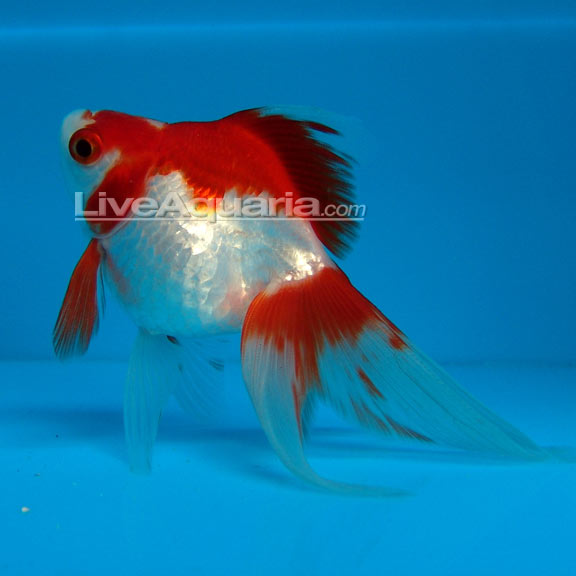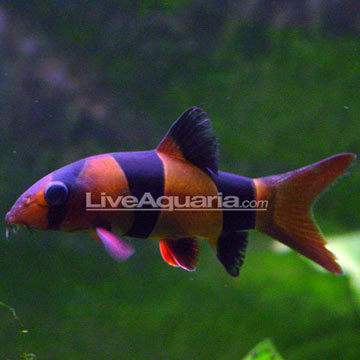| Minimum Tank Size: 30 gallons |
| Care Level: Easy |
| Temperament: Peaceful |
| Water Conditions: 65-75° F, KH 4-20, pH 6.5-7.5 |
| Max. Size: 8" |
| Color Form: Orange, Red, White |
| Diet: Omnivore |
| Compatibility: View Chart |
| Origin: Asia, China, Japan |
Family: Cyprinidae The Red & White Ryukin is a striking fish with sophisticated markings. The interplay between the white and red/orange coloration is Zen-like in its simple beauty. The Red & White Ryukin, like all Ryukin goldfish, has a prominent arch or hump immediately behind the head. A curved backbone, a fat belly, long feathery fins, a pointed mouth, and a triangular body shape are other features that differentiate the Ryukin from other goldfish varieties. As a member of the carp family, the Red & White Ryukin is generally quite hardy. They will do well in 30 gallon aquariums or larger, as well as backyard garden ponds of 180 gallons or more. In addition to a fine gravel bottom or well-rounded river rocks, the Red & White Ryukin will appreciate hardy, cold water plants. Keep in mind that goldfish are diggers and will scatter the fine sand onto leaves, injuring thin and less hardy plants. There appears to be a definite courtship ritual when goldfish breed. Breeding often results in up to 1,000 eggs, with fry hatching in five to six days. They should be fed small pieces of live or prepared foods designed for egg-laying fish. Goldfish are omnivores and will eat all types of dried and live foods. However, limit protein intake to 30% of the diet. Goldfish flake or pellet food will provide these fish with the proper nutrition. |
Thursday, June 23, 2011
Red And White Ryukin
Clown Loach
| Minimum Tank Size: 50 gallons |
| Care Level: Moderate |
| Temperament: Peaceful |
| Water Conditions: 72-86° F, KH 8-12, pH 6.0-7.5 |
| Max. Size: 1' |
| Color Form: Black, Orange, Red, Tan |
| Diet: Omnivore |
| Origin: Indonesia |
| Family: Cobitidae |

The Clown Loach is a must-have fish for many freshwater enthusiasts. It is peaceful and gets along well with almost any tankmate. The Clown Loach is also entertaining to watch and feed. Unlike true nocturnal loaches, the Clown Loach is active during the day but will shy from bright light and hide amongst plant stocks or in rockwork. Best of all, however, Botia macracantha is a voracious eater of nuisance snails that sneak into your aquarium on live plants.
Native to the waters of Indonesia, this member of the Cobitidae family appreciates caves, holes, and other hiding places amongst heavy aquarium plantings, especially when it sleeps. Because the Clown Loach is native to fast moving streams, it prefers good water movement and currents in the aquarium. Since the Clown Loach can grow to an impressive size of nearly 1 foot in length, it should be housed in larger freshwater systems.
Interestingly, the Clown Loach is sometimes referred to as a scaleless fish. But it does, in fact, have small scales embedded in its skin. For best care, feed the Clown Loach small meals several times throughout the day. Younger Clown Loaches will eat most prepared foods while older ones may be more finicky. Prepared foods such as vegetable flakes or tablets along with meaty supplements such as live, frozen, or freeze-dried worms will provide this species with the proper nutrition.
Subscribe to:
Posts (Atom)